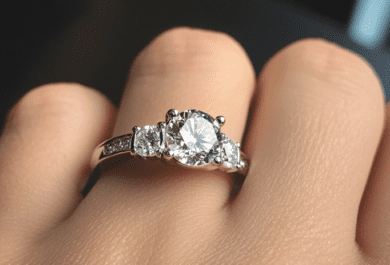When shopping online there are two possibilities for diamonds you find listed in the Pricescope search or in diamond searches on different vendor websites.
- The diamond you have found is owned and stocked by the vendor listing it. In this case that diamond will not be listed by any other vendors.
- The diamond you have found is located with a diamond supplier/manufacturer. That single diamond may appear in the lists of many vendors, any of whom may act as a broker for it.
[More information on “Why are there several dealers offering the exact same stone” may be found in this article in the PS journal: https://www.pricescope.com/journal/why_are_there_several_dealers_offering_exact_same_stone
Getting Information
When requesting information on a diamond, the amount of quickly available documents and images may vary, depending on where it is located. If it is stocked by the listing vendor the data will likely be instantly accessible. If it is located with a separate diamond supplier the availability and timeliness can vary:
Scenario 1: The vendor owns the diamond, has it in-house and has all lab reports and photos done and online. Done.
Scenario 2: The vendor owns the diamond, has it in-house and does not provide all online, but will by request. Done.
Scenario 3: A supplier owns the diamond and will provide the vendor with lab report, Sarin and photos by request. Almost done.
Scenario 4: A supplier owns the diamond and will provide the vendor with the lab report and Sarin, but no photos. This could take a little time and may require bringing the diamond in if the customer wants photos (see scenario 5).
Scenario 5: A supplier owns the diamond, and will provide the lab report – but no Sarin and no photos…The vendor is willing to bring the diamond in by request to analyze it and take photos, etc (a charge may apply depending on policies)…This does take time.
Scenario 6: A supplier owns the diamond, and will not provide anything beyond specs…The vendor is willing to bring the diamond in by request to get the lab report, analyze it, take photos, etc (again, a charge may apply)…This could take time and there is more risk that the diamond will not meet exact expectations of the vendor or buyer.
Scenario 7: A supplier owns the diamond but the vendor is a drop-ship only vendor and cannot provide anything further than what the supplier is willing to provide. This is risky to the buyer and the vendor, as the vendor will never see the diamond he/she is selling.
Internet vendors who base their business model on drop-shipping a diamond from a supplier sight-unseen to the purchaser are especially handicapped by suppliers who don’t provide ready documents and photos.
Why don’t all suppliers provide these things?
In the macro, internet sales are still not a significant enough percentage of total sales to drive change yet. It’s a twofold problem. Those who encourage suppliers to provide more information are fighting decades of ‘how it was done’ as well as a fundamental resistance to the movement that is calling for the shift (no matter how sound that decision will ultimately be).
Many long-of-tooth suppliers have traditionally done business with B&M stores who have never had a need for photos, reflectors, etc., and only recently are asking for Sarin reports. The fact that the tried and true retail vendors have operated for a generation or three without these needs, coupled with the air of resistance from influential factions within the trade to internet sales in general, causes a ‘dig in the heels’ mentality.
As internet sales increase some suppliers are coming to understand the need to provide more information digitally to internet vendors, but there are others who still do business without even owning a Sarin machine (much less photos or reflectors). What any given supplier will provide varies depending on how ‘it’s been done’ juxtaposed with current policies. Combine these unknowns with the many different vendor policies of drop-shipping sight unseen versus bringing it in for inspection and you have an alphabet soup of different scenarios.
So for customers: If you’re looking at a diamond from the virtual database, how do you know what is available from the supplier and vendor combo-platter you have chosen? In most cases you don’t. For purchase of a commonly found diamond it may not be worth your time to wait days for information, but if you’re chasing that ideal 2ct E VS with a spot-on 55% table and FL (for your mother Emily Von-Strange’s 55th birthday at the nightclub) and nothing else will do, it may be worth patience and understanding of the process if that diamond is located with a supplier who moves slowly.
There is no harm in asking if the diamond you are interested in is stocked by the vendor or by a supplier, and how timely your desired information will be. Vendors often will tell you without being asked, and don’t mind answering further questions about the expected time frame. Knowing how fast you may expect to get information, and how much information is possible, will allow you to set appropriate expectations.











